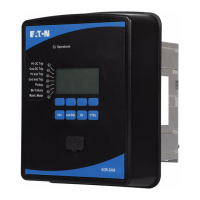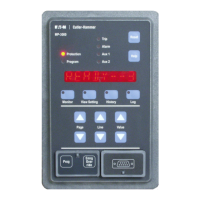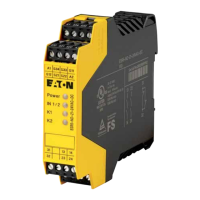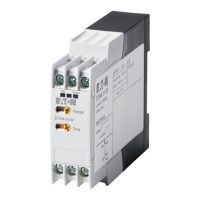Instruction Leaflet DT3000
Page 20 Effective: Date 07/02 I.B. 17555D
For more information visit: www.cutler-hammer.eaton.com
Supersedes I.B. 17555C dated November 1999
2-3 DT3000 AND DT3030 SPECIFICATIONS AND TEST SUMMARY (CONTINUED)
TIME DELAY SETTINGS:
• Inverse Time Overcurrent Time Multiplier:
It, I
2
t, I
4
t Curve: 0.2 to 40 [48 settings]
It, I
2
t, I
4
t Curve: 0.2 to 40 [47 settings] (Chicago version)
Flat: 0.2 to 2.0 [21 settings]
ANSI (all): 0.1 to 5.0 [50 settings]
IEC (all): 0.025 to 1.00 [40 settings]
IEC (all): 0.05 to 1.00 [20 settings] (Chicago version)
• Short Delay Time:
0.05 to 1.5 sec. [22 settings]
ENVIRONMENT:
• Environment:
Indoor Use Only, Pollution Degree II, Altitude 2,500m,
Installation Category II
• Mounting Location:
Device should be positioned near the main disconnect
• Operating temperature:
-30 to +55 Degrees Celsius
• Operating Humidity:
0 to 95% Relative Humidity [Non-Condensing]
• Storage Temperature:
-40 to +70 Degrees Celsius
AUXILIARY RELAYS:
(Protection Off Alarm and Trip Alarm)
• Make/Break:
5A @ 120/240Vac & 30Vdc
5A @ 120/240 Vac (Chicago version)
• Continuous:
5A @ 120/240Vac
5A @ 30Vdc
5A Continuous (Chicago version)
ADDITIONAL TESTS:
• Dielectric Strength:
Current Inputs: 3,000Vac for 1 minute Phase to Phase
• Seismic Test:
Meets requirements for UBC and California Building Code
Zone 4
ZPA = 3.5
COMMUNICATIONS:
• PowerNet Compatible / Built-in INCOM
• Data Rate is 1200 or 9600 Baud
• Set INCOM address from front panel
ZONE SELECTIVE INTERLOCKS:
• Phase:
Inverse Time Overcurrent and Short Delay
• Ground:
Inverse Time Overcurrent and Short Delay
CURRENT MONITORING:
• True rms Sensing:
3-Phase and Ground
• Display Accuracy:
+1% of Full Scale [I
n
] from 0.04 x I
n
to 1 x I
n
+2% of Full Scale [I
n
] from 1 x I
n
to 2 x I
n
• Amperes Demand:
Average Demand over 5 Minute Sampling Window
• High Load:
85% of Inverse Time Overcurrent Setting
Notes: 1. For Ground Pickup < 0.2pu; Time Tolerance ± 15%.
SECTION 3: OPERATION
3-1 INTRODUCTION
This section specifically describes the operation and
functional use of the Digitrip 3000 Protective Relay. It does
not address in detail rear power connections and DIP
switch settings. These topics are covered in SECTION 5
entitled “INSTALLATION, STARTUP AND TESTING.” It
would be helpful; however, to become familiar with the
relay’s wiring diagram before proceeding with the rest of
this section (Figure 3-1).
3-2 POWER-UP AND SELF TESTING
When the proper ac or dc control voltage is applied to
power supply input terminals, the unit will initiate a “Power
On Reset” to its chip circuitry. This causes the unit’s
firmware to perform some self-testing and initialization of
its ROM, RAM and E2 (non-volatile) memory. If any
problem exists, a diagnostic message will be displayed in
the Settings/Test Time/Trip Cause Window. A complete list
of messages and their meanings are listed in Table 3.2.
Additionally, if a problem does exist, the “Operational LED”
will light red and the “Protection Off Alarm” relay will not
energize. When all self checks are good, the “Protection
Off Alarm” relay will energize, and the “Operational LED”
will blink green.
3-3 PANEL OPERATIONS
Begin by reviewing the material presented in SECTION 2
entitled “FUNCTIONAL DESCRIPTION.” Since basic
definitions and explanations were given in SECTION 2, no
further explanation as to function will be offered in this
section. It is assumed that the operator is now familiar with
Digitrip 3000 terms, available settings and overall
capabilities.
3-3.1 CHARACTERISTIC CURVE
Digitrip 3000 Protective Relays provide circuit breakers
with an extensive degree of selective coordination potential
and permit curve shaping over a wide range. Available
pickup settings, inverse time overcurrent time multiplier
settings and inverse time overcurrent (phase and ground)
curve selections are addressed here with respect to their
effect on the resultant characteristic curve.
In general, there are three different families of curves to
choose from as shown in Table 3.1. The operating
characteristics of the relay are graphically represented by
time-current characteristic curves shown in Figure 3-2.
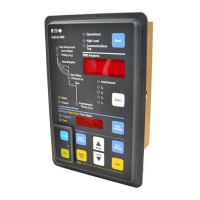
